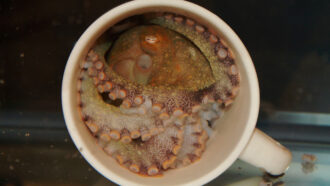The Evolution of Octopus, Squid and Cuttlefish Arms for Detecting Various Compounds

Octopuses, squid and cuttlefish have different tastes, according to two studies published in Nature on April 13. These soft-bodied cephalopods possess proteins on suckers along their tentacles, enabling them to “taste” by touching objects. Researchers have discovered that the species have evolved to detect different compounds, possibly linked to their hunting styles. Octopus evolution has led them to develop a taste for greasy things, while squid and cuttlefish evolution has enabled them to detect bitter compounds.
All species possess modified versions of proteins called neurotransmitter receptors which detect brain chemicals. Evolution has morphed the brain proteins to take on new roles as taste-sensing proteins. “This is an entirely new sensory system,” said evolutionary biologist Maude Baldwin.
Studying cephalopod receptors may offer insights into human taste-sensing proteins. “It greatly enhances our understanding of how proteins evolve in general,” said Baldwin.
Harvard physiologist Nicholas Bellono and colleagues previously discovered that barrel-shaped proteins known as chemotactile receptors in the suckers of California two-spot octopuses enable them to taste terpenes with their arms. Bellono teamed up with structural biologist Ryan Hibbs of the University of Texas Southwestern Medical Center at Dallas to examine the proteins’ detailed structure using cryoelectron microscopy.
The researchers found an unexpectedly large molecule stuck in a special pocket of the octopus protein used to detect certain chemicals. This molecule, part of the detergent used to prepare the protein for microscopy, is very different from the molecules which bind to neurotransmitter receptors from which chemotactile receptors evolved. By testing molecules collected from neighboring labs, Bellono’s team determined that octopus receptors can detect a variety of “greasy, sticky molecules” which don’t dissolve in water. Squid and cuttlefish have modified neurotransmitter receptors in their suckers, but some detect bitter compounds which can diffuse in water, unlike the greasy ones octopuses detect.\n
The type of receptors the species have reflect their hunting strategies. Octopuses ”explore everything with their arms,” Bellono says, and likely use chemotactile receptors to guide their explorations. While octopuses use sight to catch prey out in the light of day, chemotactile receptors help them hunt in the dark and to find prey hidden in cracks and crevices, Bellono says. Squid and cuttlefish are ambush predators that rely on eyesight alone. The bitter receptors help squid decide whether to eat their prey only after they have it in their grasp.
The octopus and squid receptors evolved about 300 million years ago, early in the species’ histories. But it’s impossible to tell whether hunting style or receptor type came first or if the traits evolved together.
Octopuses also have another type of chemotactile receptor, the researchers found, but they don’t yet know what sorts of molecules those receptors sense.
It will take years to work out the details of what all the cephalopods’ receptors detect and how they influence animals’ behavior, Zakon says. “This is really a first announcement that these receptors have changed in fundamentally important ways.”




